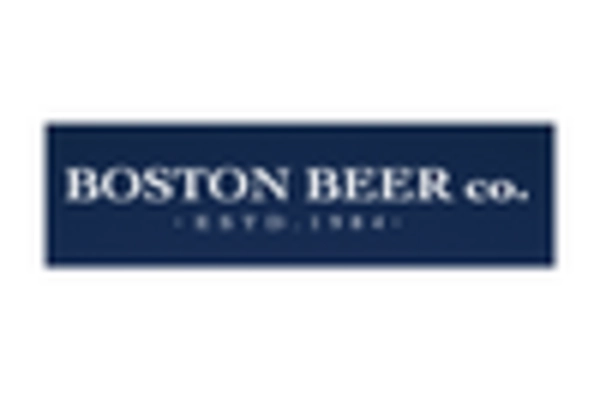-
Executive Summary
-
Scope of the Report
-
2.1
-
Market Definition
-
Scope of the Study
- Research Objective
-
2.2.2
-
Assumptions & Limitations
-
Markets Structure
-
Market Research
-
Methodology
-
Research Function
-
Secondary Research
-
Primary
-
Research
-
Forecast Model
-
Market Landscape
-
Supply Chain Analysis
- Raw Material Suppliers
- Manufacturers/Producers
- Distributors/Retailers/Wholesalers/E-Commerce
- End-Users
-
Porter’s Five Forces Analysis
- Threat
- Bargaining Power of Buyers
- Bargaining Power
- Threat of Substitutes
- Intensity of Competitive
-
of New Entrants
-
of Suppliers
-
Rivalry
-
Market Dynamics of Global Fruit Beer Market
-
Introduction
-
Drivers
-
Restraints
-
Opportunities
-
Challenges
-
Global Fruit Beer Market, by Flavor
-
Introduction
-
Peach
- Market Estimates & Forecast, 2023–2032
- Market Estimates
-
& Forecast, by Region, 2023–2032
-
Raspberry
- Market
- Market Estimates & Forecast,
-
Estimates & Forecast, 2023–2032
-
by Region, 2023–2032
-
Cherry
- Market Estimates & Forecast,
- Market Estimates & Forecast, by Region, 2023–2032
-
Apricot
- Market Estimates & Forecast, 2023–2032
-
6.5.2
-
Market Estimates & Forecast, by Region, 2023–2032
-
Apple
- Market Estimates &
-
6.6.1
-
Market Estimates & Forecast, 2023–2032
-
Forecast, by Region, 2023–2032
-
Others
- Market Estimates
- Market Estimates & Forecast, by Region,
-
& Forecast, 2023–2032
-
Global Fruit Beer Market, by Distribution channel
-
7.1
-
Introduction
-
Store-Based
- Departmental Store
- Bars & Restaurants
- Supermarket
-
Estimates & Forecast, 2023–2032
-
by Region, 2023–2032
-
Estimates & Forecast, 2023–2032
-
by Region, 2023–2032
-
& Forecast, 2023–2032
-
Non Store-Based
- Market Estimates &
- Market Estimates & Forecast, by Region,
-
Forecast, by, 2023–2032
-
Global Fruit Beer Market, by Region
-
Introduction
-
North America
- Market Estimates & Forecast, 2023–2032
- Market Estimates & Forecast, by Flavor2023–2032
- Market
- U.S.
- Canada
- Mexico
-
Estimates & Forecast, by Distribution channel, 2023–2032
-
& Forecast, by Flavor2023–2032
-
by Distribution channel, 2023–2032
-
& Forecast, 2023–2032
-
flavor 2023–2032
-
channel, 2023–2032
-
Europe
- Market Estimates & Forecast, 2023–2032
-
8.3.2
-
Market Estimates & Forecast, by Flavor2023–2032
-
& Forecast, by Distribution channel, 2023–2032
-
8.3.4.1
-
Market Estimates & Forecast, 2023–2032
-
Forecast, by Flavor2023–2032
-
by Distribution channel 2023–2032
-
& Forecast, 2023–2032
-
Flavor2023–2032
-
channel, 2023–2032
-
8.3.6.2
-
Market Estimates
-
Germany
-
Market Estimates &
-
Market Estimates & Forecast,
-
France
-
Market Estimates
-
Market Estimates & Forecast, by
-
Market Estimates & Forecast, by Distribution
-
Italy
-
Market Estimates & Forecast,
-
Market Estimates & Forecast, by Flavor2023–2032
-
Market Estimates & Forecast, by Distribution channel, 2023–2032
-
Spain
-
Market Estimates & Forecast, 2023–2032
-
Market Estimates & Forecast, by Flavor2023–2032
-
& Forecast, by Distribution channel, 2023–2032
-
8.3.8.1
-
Market Estimates & Forecast, 2023–2032
-
Forecast, by Flavor2023–2032
-
by Distribution channel, 2023–2032
-
8.3.9.1
-
Market Estimates & Forecast, 2023–2032
-
Forecast, Flavor2023–2032
-
Distribution channel, 2023–2032
-
& Forecast, 2023–2032
-
8.4.4.2
-
Market Estimates
-
U.K
-
Market Estimates &
-
Market Estimates & Forecast,
-
Rest of Europe
-
Market Estimates &
-
Market Estimates & Forecast, by
-
Asia-Pacific
- Market Estimates
- Market Estimates & Forecast, by Flavor2023–2032
- Market Estimates & Forecast, by Distribution channel, 2023–2032
- Japan
-
Market Estimates & Forecast, by Flavor2023–2032
-
& Forecast, by Distribution channel, 2023–2032
-
8.4.5.1
-
Market Estimates & Forecast, 2023–2032
-
Forecast, by Flavor2023–2032
-
by Distribution channel, 2023–2032
-
& Forecast, 2023–2032
-
Flavor2023–2032
-
channel, 2023–2032
-
Estimates & Forecast, 2023–2032
-
by Flavor2023–2032
-
channel, 2023–2032
-
& Forecast, 2023–2032
-
Flavor2023–2032
-
channel, 2023–2032
-
& Forecast, 2023–2032
-
8.5.4.3
-
Market Estimates
-
China
-
Market Estimates &
-
Market Estimates & Forecast,
-
India
-
Market Estimates
-
Market Estimates & Forecast, by
-
Market Estimates & Forecast, by Distribution
-
Australia & New Zealand
-
Market
-
Market Estimates & Forecast,
-
Market Estimates & Forecast, by Distribution
-
Rest of Asia-Pacific
-
Market Estimates
-
Market Estimates & Forecast, by
-
Market Estimates & Forecast, by Distribution
-
Rest of the World
- Market Estimates
- Market Estimates & Forecast, by Flavor2023–2032
- Market Estimates & Forecast, by Distribution channel, 2023–2032
- South America
-
Market Estimates & Forecast, by Distribution channel, 2023–2032
-
8.5.5
-
The Middle East
-
8.5.5.3
-
Market Estimates & Forecast, 2023–2032
-
Market Estimates & Forecast, by Flavor2023–2032
-
Market Estimates & Forecast, by Distribution channel, 2023–2032
-
8.5.6
-
Africa
-
8.5.6.2
-
Market Estimates & Forecast, 2023–2032
-
Market Estimates & Forecast, by Flavor2023–2032
-
& Forecast, by Distribution channel, 2023–2032
-
Market Estimates
-
Company Landscape
-
Introduction
-
Market Strategy
-
Key Development Analysis
-
(Expansions/Mergers & Acquisitions/Joint Ventures/New Product Developments/Agreements/Investments)
-
Company Profiles
-
Joseph James Brewing Company, Inc. (U.S.)
- Financial Updates
- Product/Business Segment
- Strategy
- Key Developments
- SWOT Analysis
-
10.1.1
-
Company Overview
-
Overview
-
New Belgium Brewing Company (U.S.)
- Company Overview
- Product/Business Segment Overview
- Strategy
- Key Developments
- SWOT Analysis
-
10.2.2
-
Financial Updates
-
Brewery Ommegang (U.S.)
- Company Overview
- Financial Updates
- Product/Business
- Strategy
- Key Developments
- SWOT
-
Segment Overview
-
Analysis
-
All Saints Brewing Company (U.S.)
- Company Overview
- Financial Updates
- Product/Business Segment Overview
- Key Developments
- SWOT Analysis
-
10.4.4
-
Strategy
-
Lindemans
- Company Overview
- Financial Updates
- Product/Business Segment Overview
- Strategy
- Key
- SWOT Analysis
-
Brewery (Belgium)
-
Developments
-
Lost Coast Brewery (U.S.)
- Financial Updates
- Product/Business Segment
- Strategy
- Key Developments
- SWOT Analysis
-
10.6.1
-
Company Overview
-
Overview
-
Magic Hat Brewing Company (U.S.)
- Company Overview
- Product/Business Segment Overview
- Strategy
- Key Developments
- SWOT Analysis
-
10.7.2
-
Financial Updates
-
Shipyard Brewing Company
- Company Overview
- Financial Updates
- Product/Business
- Strategy
- Key Developments
- SWOT
-
(U.S.)
-
Segment Overview
-
Analysis
-
Unibroue, Wells & Young’s Ltd (U.K)
- Company
- Financial Updates
- Product/Business Segment Overview
- Strategy
- Key Developments
- SWOT Analysis
- Company Overview
- Product/Business Segment Overview
- Strategy
- Key Developments
- SWOT Analysis
-
Overview
-
10.10
-
Brouwerij Van Honsebrouck N.V. (Belgium)
-
10.10.2
-
Financial Updates
-
Abita Brewing Co.
- Company Overview
- Financial Updates
- Strategy
- Key Developments
- SWOT Analysis
-
(U.S)
-
10.11.3
-
Product/Business Segment Overview
-
11.Conclusion
-
LIST OF TABLES
-
Global
-
Fruit Beer Market, by Region, 2023–2032
-
North America: Fruit
-
Beer Market, by Country, 2023–2032
-
Europe: Fruit Beer Market,
-
by Country, 2023–2032
-
Asia-Pacific: Fruit Beer Market, by Country,
-
Middle East & Africa: Fruit Beer Market, by Country,
-
South America: Fruit Beer Market, by Country, 2023–2032
-
Global Fruit Beer Flavor Market, by Region, 2023–2032
-
Table
-
North America: Fruit Beer Flavor Market, by Country, 2023–2032
-
Table
-
Europe: Fruit Beer Flavor Market, by Country, 2023–2032
-
Table10 Asia-Pacific:
-
Fruit Beer Flavor Market, by Country, 2023–2032
-
Table11 Middle East &
-
Africa: Fruit Beer Flavor Market, by Country, 2023–2032
-
Table12 South
-
America: Fruit Beer Flavor Market, by Country, 2023–2032
-
Table13 Global
-
Fruit Beer Distribution Channel Market, by Region, 2023–2032
-
Table14
-
North America: Fruit Beer Distribution Channel Market, by Country, 2023–2032
-
Table15 Europe: Fruit Beer Distribution Channel Market, by Country, 2023–2032
-
Table16 Asia-Pacific: Fruit Beer Distribution Channel Market, by Country, 2023–2032
-
Table17 Middle East & Africa: Fruit Beer Distribution Channel Market, by Country,
-
Table18 South America: Fruit Beer Distribution Channel Market,
-
by Country, 2023–2032
-
Table19 Global Flavor Market, by Region, 2023–2032
-
Table20 Global Distribution channel Market, by Region, 2023–2032
-
Table21
-
North America: Fruit Beer Market, by Country
-
Table22 North America: Fruit Beer
-
Market, by Flavor
-
Table23 North America: Fruit Beer Market, by Distribution
-
Channel
-
Table24 Europe: Fruit Beer Market, by Country
-
Table25 Europe:
-
Fruit Beer Market, by Flavor
-
Table26 Europe: Fruit Beer Market, by Distribution
-
channel
-
Table27 Asia-Pacific: Fruit Beer Market, by Country
-
Table28 Asia-Pacific:
-
Fruit Beer Market, by Flavor
-
Table29 Asia-Pacific: Fruit Beer Market, by Distribution
-
channel
-
Table30 Middle East & Africa: Fruit Beer Market, by Country
-
Table31 Middle East & Africa Fruit Beer Market, by Flavor
-
Table32 Middle
-
East & Africa Fruit Beer Market, by Distribution channel
-
Table33 South
-
America: Fruit Beer Market, by Country
-
Table34 South America Fruit Beer Market,
-
by Flavor
-
Table35 South America Fruit Beer Market, by Distribution channel
-
LIST OF FIGURES
-
Global Fruit Beer Market Segmentation
-
FIGURE
-
Forecast Research Methodology
-
Five Forces Analysis of Global Fruit
-
Beer Market
-
Value Chain of Global Fruit Beer Market
-
FIGURE 5
-
Share of Global Fruit Beer Market in 2023, by Country (%)
-
Global Fruit
-
Beer Market, 2023–2032,
-
Global Fruit Beer Market Size by Flavor,
-
Share of Global Fruit Beer Market, by Flavor, 2023–2032
-
Global Fruit Beer Market Size, by Distribution channel, 2023
-
FIGURE
-
Share of Global Fruit Beer Market, by Distribution channel, 2023–2032










Leave a Comment